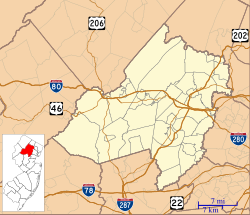United States Army 4039
 From Wikipedia - Reading time: 7 min
From Wikipedia - Reading time: 7 min
| United States Army 4039 | |||||||||||||||||||||||||||||||||||||||||||||||||
|---|---|---|---|---|---|---|---|---|---|---|---|---|---|---|---|---|---|---|---|---|---|---|---|---|---|---|---|---|---|---|---|---|---|---|---|---|---|---|---|---|---|---|---|---|---|---|---|---|---|
 USATC N. 4039 awaiting restoration at Whipanny Train Museum | |||||||||||||||||||||||||||||||||||||||||||||||||
| |||||||||||||||||||||||||||||||||||||||||||||||||
| |||||||||||||||||||||||||||||||||||||||||||||||||
| |||||||||||||||||||||||||||||||||||||||||||||||||
United States Army Steam Locomotive No. 4039 is located in the Whippany section of Hanover Township, Morris County, New Jersey, United States. The locomotive was built in 1942 and added to the National Register of Historic Places on March 4, 2002. The locomotive is part of the Whippany Railway Museum.
History
[edit]The locomotive was built by the American Locomotive Company in November 1942 for the U.S. War Department.[3] The locomotive is an S155 class 0-6-0 "Switching"-type built for Standard gauge track. The intended use of the locomotive was for U.S. military service in the Far East, Africa and Europe, but instead was used for switching operations for military bases within the United States during World War II.[4] After World War II the locomotive was no longer needed by the War Department and was sold to the Virginia Blue Ridge Railway on February 17, 1947.[3] The locomotive was used in freight operations until August 1, 1963 when it was retired from revenue service, after that, the Virginia Blue Ridge Railway made the change over to diesel locomotives.[4][3]
In 1965, the locomotive was sold to the Morris County Central Railroad were it was converted to burn oil and was restored on August 27, 1966 and used for passenger rail excursions.[3] The locomotive's last run was on December 14, 1980, between Newfoundland and Stockholm, New Jersey. The Whippany Railway Museum acquired the locomotive on May 7, 1994, and cosmetically restored it for static display. The Morris County Board of Chosen Freeholders adopted a Resolution designating the locomotive "The Official Steam Locomotive of Morris County" on January 26, 1997.[4] As of 2015, the engine is currently undergoing restoration to operating condition, when restored, it will run primarily on local area railroads.[4][3]
See also
[edit]- National Register of Historic Places listings in Morris County, New Jersey
- Southern Railway 385
- Duluth and Northeastern 29
- Tennessee Valley Railroad 610
- Wilmington and Western 58
References
[edit]- ^ "National Register Information System". National Register of Historic Places. National Park Service. March 13, 2009.
- ^ "New Jersey and National Registers of Historic Places – Morris County" (PDF). New Jersey Department of Environmental Protection – Historic Preservation Office. July 7, 2009. p. 19. Archived from the original (PDF) on June 4, 2011. Retrieved March 24, 2010.
- ^ a b c d e "Steam Locomotive No. 4039". Retrieved October 14, 2024.
- ^ a b c d "Steam Locomotive No. 4039". Retrieved December 10, 2010.
 KSF
KSF

